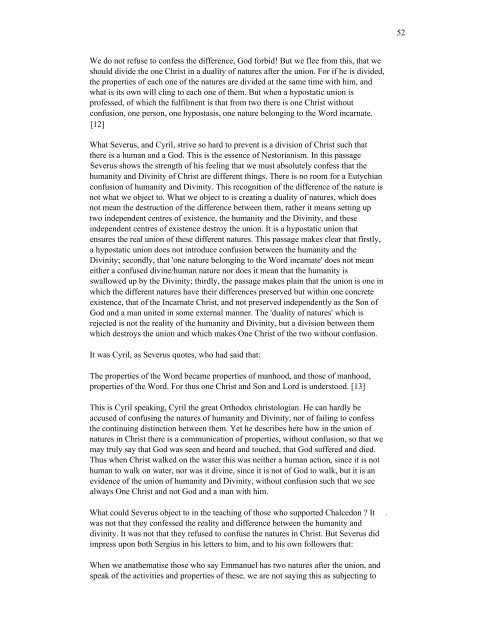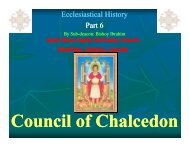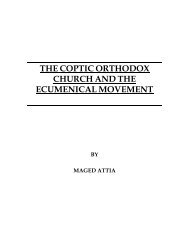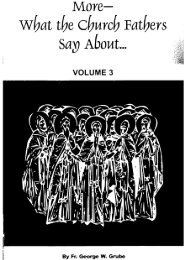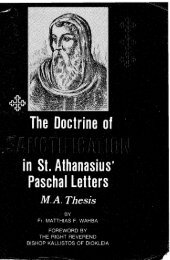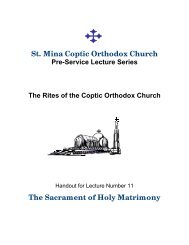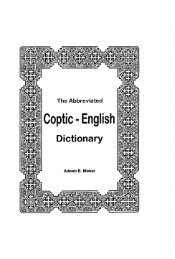Coptic interpretations of the Fourth Ecumenical Council - Saint Mina ...
Coptic interpretations of the Fourth Ecumenical Council - Saint Mina ...
Coptic interpretations of the Fourth Ecumenical Council - Saint Mina ...
You also want an ePaper? Increase the reach of your titles
YUMPU automatically turns print PDFs into web optimized ePapers that Google loves.
We do not refuse to confess <strong>the</strong> difference, God forbid! But we flee from this, that we<br />
should divide <strong>the</strong> one Christ in a duality <strong>of</strong> natures after <strong>the</strong> union. For if he is divided,<br />
<strong>the</strong> properties <strong>of</strong> each one <strong>of</strong> <strong>the</strong> natures are divided at <strong>the</strong> same time with him, and<br />
what is its own will cling to each one <strong>of</strong> <strong>the</strong>m. But when a hypostatic union is<br />
pr<strong>of</strong>essed, <strong>of</strong> which <strong>the</strong> fulfilment is that from two <strong>the</strong>re is one Christ without<br />
confusion, one person, one hypostasis, one nature belonging to <strong>the</strong> Word incarnate.<br />
[12]<br />
What Severus, and Cyril, strive so hard to prevent is a division <strong>of</strong> Christ such that<br />
<strong>the</strong>re is a human and a God. This is <strong>the</strong> essence <strong>of</strong> Nestorianism. In this passage<br />
Severus shows <strong>the</strong> strength <strong>of</strong> his feeling that we must absolutely confess that <strong>the</strong><br />
humanity and Divinity <strong>of</strong> Christ are different things. There is no room for a Eutychian<br />
confusion <strong>of</strong> humanity and Divinity. This recognition <strong>of</strong> <strong>the</strong> difference <strong>of</strong> <strong>the</strong> nature is<br />
not what we object to. What we object to is creating a duality <strong>of</strong> natures, which does<br />
not mean <strong>the</strong> destruction <strong>of</strong> <strong>the</strong> difference between <strong>the</strong>m, ra<strong>the</strong>r it means setting up<br />
two independent centres <strong>of</strong> existence, <strong>the</strong> humanity and <strong>the</strong> Divinity, and <strong>the</strong>se<br />
independent centres <strong>of</strong> existence destroy <strong>the</strong> union. It is a hypostatic union that<br />
ensures <strong>the</strong> real union <strong>of</strong> <strong>the</strong>se different natures. This passage makes clear that firstly,<br />
a hypostatic union does not introduce confusion between <strong>the</strong> humanity and <strong>the</strong><br />
Divinity; secondly, that 'one nature belonging to <strong>the</strong> Word incarnate' does not mean<br />
ei<strong>the</strong>r a confused divine/human nature nor does it mean that <strong>the</strong> humanity is<br />
swallowed up by <strong>the</strong> Divinity; thirdly, <strong>the</strong> passage makes plain that <strong>the</strong> union is one in<br />
which <strong>the</strong> different natures have <strong>the</strong>ir differences preserved but within one concrete<br />
existence, that <strong>of</strong> <strong>the</strong> Incarnate Christ, and not preserved independently as <strong>the</strong> Son <strong>of</strong><br />
God and a man united in some external manner. The 'duality <strong>of</strong> natures' which is<br />
rejected is not <strong>the</strong> reality <strong>of</strong> <strong>the</strong> humanity and Divinity, but a division between <strong>the</strong>m<br />
which destroys <strong>the</strong> union and which makes One Christ <strong>of</strong> <strong>the</strong> two without confusion.<br />
It was Cyril, as Severus quotes, who had said that:<br />
The properties <strong>of</strong> <strong>the</strong> Word became properties <strong>of</strong> manhood, and those <strong>of</strong> manhood,<br />
properties <strong>of</strong> <strong>the</strong> Word. For thus one Christ and Son and Lord is understood. [13]<br />
This is Cyril speaking, Cyril <strong>the</strong> great Orthodox christologian. He can hardly be<br />
accused <strong>of</strong> confusing <strong>the</strong> natures <strong>of</strong> humanity and Divinity, nor <strong>of</strong> failing to confess<br />
<strong>the</strong> continuing distinction between <strong>the</strong>m. Yet he describes here how in <strong>the</strong> union <strong>of</strong><br />
natures in Christ <strong>the</strong>re is a communication <strong>of</strong> properties, without confusion, so that we<br />
may truly say that God was seen and heard and touched, that God suffered and died.<br />
Thus when Christ walked on <strong>the</strong> water this was nei<strong>the</strong>r a human action, since it is not<br />
human to walk on water, nor was it divine, since it is not <strong>of</strong> God to walk, but it is an<br />
evidence <strong>of</strong> <strong>the</strong> union <strong>of</strong> humanity and Divinity, without confusion such that we see<br />
always One Christ and not God and a man with him.<br />
What could Severus object to in <strong>the</strong> teaching <strong>of</strong> those who supported Chalcedon ? It<br />
was not that <strong>the</strong>y confessed <strong>the</strong> reality and difference between <strong>the</strong> humanity and<br />
divinity. It was not that <strong>the</strong>y refused to confuse <strong>the</strong> natures in Christ. But Severus did<br />
impress upon both Sergius in his letters to him, and to his own followers that:<br />
When we ana<strong>the</strong>matise those who say Emmanuel has two natures after <strong>the</strong> union, and<br />
speak <strong>of</strong> <strong>the</strong> activities and properties <strong>of</strong> <strong>the</strong>se, we are not saying this as subjecting to<br />
52


